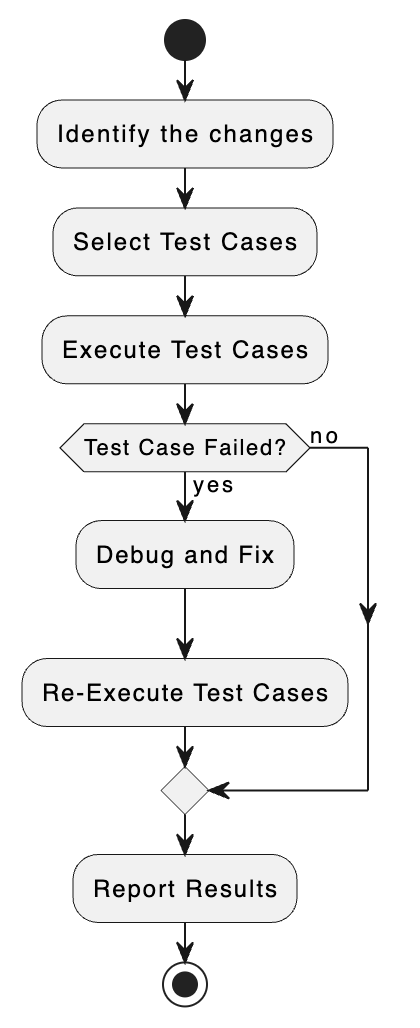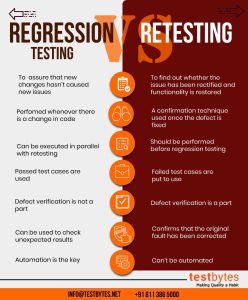
7 Types of Regression Testing Methods You Should Know
January 20th, 2024

It is common for companies to introduce minor changes from time to time to their products.
However, introducing these changes affects the application in numerous ways, such as its functionality, performance, bugs, etc.
Therefore, it is important to keep the testing process on whether the software is on the market or a small change has been introduced.
Conducting this type of testing is known as regression testing.
What is Regression Testing?
Regression testing is a type of software testing that aims to ensure that recent code changes have not adversely affected existing features. It involves re-running test cases that have been executed in the past to verify that the existing functionality still performs as expected after the introduction of new code.
The primary goal of regression testing is to uncover any defects that may have been inadvertently introduced as a result of the code modifications. This type of testing helps maintain the overall integrity of the software and prevents the reoccurrence of previously fixed bugs.

Benefits of Regression Testing
While the basic aim behind conducting regression testing is to identify bugs that might have developed due to the changes introduced, conducting this test benefits in a number of ways, such as:
- Increase chances of detecting bugs caused due to new changes introduced in the software
- Helps in identifying undesirable side effects that might have been caused due to a new operating environment
- Ensures better-performing software due to early identification of bugs and errors
- Highly beneficial in situations when continuous changes are introduced in the product
- Helps in maintaining high product quality
Types of Regression Testing
There are a number of ways in which this testing can be done. However, this depends on factors such as the type of changes introduced, bugs fixed, etc.
Some of the common types of regression testing include:
1) Corrective Regression Testing:
Corrective regression testing is a type of software testing that focuses on verifying that specific issues or defects, which were identified and fixed in the software, have been successfully resolved without introducing new problems. The primary goal is to ensure that the changes made to address reported bugs or issues do not negatively impact the existing functionality of the application.
Here’s an example of corrective regression testing:
Scenario: Corrective Regression Testing for Login Functionality
Initial State:
- Application with a login page.
- A bug was reported stating that the application allows access with incorrect credentials.
Bug Details:
- Bug ID: BUG-12345
- Description: Users can log in with invalid credentials.
Steps to Reproduce (Before Fix):
- Open the application login page.
- Enter an invalid username.
- Enter an invalid password.
- Click on the “Login” button.
- Verify that the user is logged in, despite providing incorrect credentials.
Steps to Fix:
- Developers investigate and identify the code causing the issue.
- Code is modified to validate user credentials properly.
- The fix is implemented and tested locally.
Corrective Regression Testing:
Positive Test Case (After Fix):
Test Steps:
- Open the application login page.
- Enter valid username.
- Enter valid password.
- Click on the “Login” button.
Expected Result:
- User should be successfully logged in.
- Verify that the user is redirected to the dashboard.
Negative Test Case (After Fix):
Test Steps:
- Open the application login page.
- Enter invalid username.
- Enter invalid password.
- Click on the “Login” button.
Expected Result:
- User should not be logged in.
- An error message should be displayed.
@Test
public void testCorrectiveRegression() {
// Positive test case (after fix)
// Test steps to open login page, enter valid credentials, and click login
// Assert statements to verify successful login and redirection
// Negative test case (after fix)
// Test steps to open login page, enter invalid credentials, and click login
// Assert statements to verify login failure and error message presence
}
This example demonstrates how corrective regression testing ensures that the specific bug (allowing login with invalid credentials) has been successfully addressed without introducing new issues in the login functionality.
2) Retest-all Regression Testing:
Retest-All regression testing, also known as a complete regression test, involves re-executing the entire test suite, including both new and existing test cases, to validate the modified code.
In this approach, every test case is retested to ensure that the changes made to the software have not introduced any new defects and that the existing functionalities remain unaffected.
Example: Suppose a software application undergoes a major update, and several changes are made to the codebase. In a retest-all regression testing scenario, the testing team would execute all the test cases, covering various features and functionalities of the application, to verify that the changes have not caused any unintended side effects. This comprehensive approach ensures that the entire application is thoroughly validated, providing confidence in the stability and reliability of the updated software.
Also Read:- Top 25 Software Testing Companies to Look Out For in 2024
3) Selective Regression Testing:
Selective regression testing is a software testing strategy where a subset of test cases is chosen based on the areas of the code that have undergone changes. The goal is to verify that the recent modifications have not negatively impacted the existing functionality of the application.
Here’s an example of selective regression testing:
Scenario: Selective Regression Testing for E-commerce Checkout Process
Initial State:
- An e-commerce application with a functional checkout process.
- Recent changes were made to optimize the checkout page.
Changes Made:
- Developers modified the code related to the payment processing module to improve performance.
Steps to Perform Selective Regression Testing:
- Identify the Modified Area:
- Identify the specific module or area of the application that has undergone changes. In this case, it’s the payment processing module.
- Select Test Cases:
- Choose a subset of test cases related to the payment processing and checkout process. Consider scenarios that the recent changes are likely to affect.
- Execute Test Cases:
- Execute the selected test cases to ensure that the recent modifications have not introduced defects in the payment processing functionality.
- Validate Existing Functionality:
- While the primary focus is on the modified area, it’s essential to validate that existing functionality outside the modified scope continues to work as expected.
Example Test Cases for Selective Regression Testing:
Test Case 1: Positive Payment Processing
Test Steps:
- Add items to the cart.
- Proceed to the checkout page.
- Enter valid shipping details.
- Enter valid payment information.
- Complete the purchase.
Expected Result:
- Payment is processed successfully.
- Order confirmation is displayed.
Test Case 2: Negative Payment Processing
Test Steps:
- Add items to the cart.
- Proceed to the checkout page.
- Enter valid shipping details.
- Enter invalid payment information.
- Attempt to complete the purchase.
Expected Result:
- Payment failure is handled gracefully.
- User receives an appropriate error message.
Selenium Code (Java):
@Test
public void testPositivePaymentProcessing() {
// Test steps to simulate positive payment processing
// Assert statements to verify successful payment and order confirmation
}
@Test
public void testNegativePaymentProcessing() {
// Test steps to simulate negative payment processing
// Assert statements to verify proper handling of payment failure and error message
}
In this example, selective regression testing focuses on a specific area (payment processing) that underwent recent changes. The chosen test cases help ensure that the optimizations made to the checkout page did not introduce issues in the payment processing functionality.
4) Progressive Regression Testing:
Progressive regression testing is an approach in software testing where new test cases are added to the existing test suite gradually, ensuring that the application’s new features or modifications are thoroughly tested without compromising the testing efficiency. It involves building upon the existing test suite with each development cycle, making it a continuous and evolving process.
Example Scenario: Progressive Regression Testing in an E-learning Platform
Initial State:
- An e-learning platform with features like course enrollment, quiz submissions, and user profiles.
- Ongoing development to introduce a new feature: real-time collaboration on assignments.
Development Cycle 1:
- Developers implement the initial version of the real-time collaboration feature.
Progressive Regression Testing Steps:
- Existing Test Suite:
- The current test suite includes test cases for course enrollment, quiz submissions, and user profiles.
- Identify Impact Area:
- Identify the potential impact of the new feature on existing functionality. Focus on areas such as user profiles, user interactions, and database changes.
- Create New Test Cases:
- Develop new test cases specifically targeting the real-time collaboration feature. These may include scenarios like simultaneous document editing and version control.
- Add to Test Suite:
- Integrate the new test cases into the existing test suite.
- Execute Test Suite:
- Run the entire test suite, covering both existing and newly added test cases.
- Review and Update:
- Review the test results and update the test suite based on any identified issues or changes in the application.
Progressive Regression Testing Cycle:
- Development Cycle 2:
- Developers enhance the real-time collaboration feature and introduce another new feature: discussion forums.
- Repeat Steps 2-6:
- Identify the impact area, create new test cases for the discussion forums, integrate them into the test suite, and execute the updated suite.
Selenium Code (Java) for Progressive Regression Testing:
@Test
public void testRealTimeCollaboration() {
// Test steps for real-time collaboration feature
// Assertions to validate collaboration functionalities
}
@Test
public void testDiscussionForums() {
// Test steps for discussion forums feature
// Assertions to validate forum interactions
}
5) Complete Regression Testing:
Here’s a comprehensive explanation of Complete Regression Testing with examples:
Complete Regression Testing, also known as Full Regression Testing, is a type of testing that involves re-executing all existing test cases for an application after any change or modification is made. It aims to ensure that no new bugs or defects have been introduced as a result of the changes and that all previously working features continue to operate as expected.
Key Characteristics:
- Comprehensive Coverage: It covers all functionalities of the application, providing the highest level of confidence in its stability.
- Time-Consuming: It can be a time-intensive process, especially for large and complex applications with extensive test suites.
- Resource-Intensive: It often requires significant effort and resources to execute all test cases.
- Ideal for Critical Changes: It’s best suited for major updates, releases, or when confidence in the application’s stability is paramount.
Example:
Consider a banking application that has undergone a significant upgrade, including changes to its login process, account management features, and fund transfer functionalities. To ensure that the upgrade hasn’t introduced any unintended bugs, the testing team would perform Complete Regression Testing. This would involve re-running all existing test cases for:
- Login process: Testing various login scenarios (valid/invalid credentials, password reset, multi-factor authentication).
- Account management: Creating, viewing, editing, and deleting accounts.
- Fund transfers: Initiating transfers between accounts, handling different amounts and currencies, checking transaction history.
- Other functionalities: Any other features or modules within the application.
Advantages:
- Highest Level of Confidence: Provides assurance that changes haven’t compromised existing functionalities.
- Uncovers Unexpected Issues: May reveal bugs in seemingly unrelated areas due to code dependencies.
Disadvantages:
- Time and Resource Intensive: Can be costly and delay release cycles.
- May Not Be Necessary for Minor Changes: Could be overkill for small updates with isolated impact.
Best Practices:
- Prioritize Based on Risk: Focus on critical functionalities and areas with higher risk of regression.
- Automate Wherever Possible: Use automation tools to reduce manual effort and improve efficiency.
- Combine with Other Techniques: Consider Partial Regression Testing or Selective Regression Testing for more focused approaches.
- Utilize Risk Analysis: Identify high-risk areas to prioritize testing efforts.
- Plan for Sufficient Time and Resources: Allocate adequate time and resources for Complete Regression Testing in project schedules.
6) Manual Regression Testing
Manual Regression Testing involves re-executing existing test cases without the use of automated tools. It relies on human testers to manually perform the testing steps and verify the results.
Key Characteristics:
- Human-Driven: Testers manually execute test cases, relying on their expertise and judgment.
- Flexibility: Allows for exploration and adaptation of test cases during execution.
- Suitable for Complex Scenarios: Effective for testing intricate user interactions or scenarios that are difficult to automate.
- Time-Consuming: Can be slower than automated testing, especially for large test suites.
- Prone to Human Error: Testers may inadvertently introduce errors during manual execution.
Example:
Consider a web application that has undergone changes to its checkout process. To ensure the changes haven’t introduced regressions, a tester would perform manual regression testing by:
- Reviewing Test Cases: Analyzing existing test cases covering the checkout process.
- Executing Test Steps: Manually navigating through the checkout steps, entering data, and clicking buttons as specified in the test cases.
- Observing Results: Carefully observing the application’s behavior, checking for errors, unexpected outcomes, or inconsistencies.
- Comparing Results: Verifying that the observed behavior matches the expected behavior defined in the test cases.
- Reporting Issues: Documenting any bugs or defects found during testing.
7) Unit Regression Testing
Unit Regression Testing involves the testing of individual units or components of a software application to ensure that new code changes or modifications do not adversely affect the existing functionalities. It focuses on verifying the correctness of specific units of code after each change, providing quick feedback to developers. Below is an example scenario demonstrating Unit Regression Testing.
Example Scenario: Unit Regression Testing for a Login Module
Initial State:
- A web application with a login module containing functions for user authentication.
- Ongoing development to enhance the security features of the login process.
Unit Regression Testing Steps:
- Existing Unit Test for Login Functionality:
- Initial unit tests cover basic login functionality, checking username-password validation.
- Development Cycle 1:
- Developers implement changes to enhance security, introducing two-factor authentication (2FA).
- Unit Regression Testing Cycle:a. Identify Affected Units:
- Identify the precise components or operations of the login module that the security enhancement affects.
b. Modify Existing Test Cases:
- Update existing unit test cases for the login module to include scenarios related to 2FA.
c. Create New Test Cases:
- Develop new unit test cases specifically targeting the new security features, such as testing OTP (One-Time Password) generation and validation.
d. Execute Unit Tests:
- Run the modified and new unit tests to verify the correctness of the login module’s updated code.
e. Review and Update:
- Review the test results, update unit tests based on any identified issues, and ensure that the existing functionality remains intact.
Unit Regression Testing Code (Java) for Enhanced Login Module:
public class LoginModuleTest {
@Test
public void testBasicLoginFunctionality() {
// Original unit test for basic login functionality
// Assertions to validate username-password validation
}
@Test
public void testTwoFactorAuthentication() {
// New unit test for enhanced security with two-factor authentication
// Assertions to validate OTP generation and validation
}
}
In this example, unit regression testing ensures that modifications to the login module, particularly the introduction of two-factor authentication, do not introduce regressions or negatively impact the existing login functionality. It allows for quick validation at the unit level, enabling developers to catch and address issues early in the development process.
8) Automated Regression Testing
Automated regression testing involves using automated test scripts to re-run existing test cases and verify the unchanged parts of the software after a code change.
This approach uses specialized tools and scripts to execute repetitive tests, allowing for quick validation of the application’s existing functionalities.
Example: In a web application, after implementing new features or making changes to the existing code, automated regression testing can be employed to ensure that previously working features have not been negatively impacted.
For instance, if an e-commerce website adds a new payment gateway, automated regression testing can be used to verify that the existing product browsing, selection, and checkout processes still function correctly after the integration of the new payment system.
Automated regression testing helps maintain the overall quality and stability of the application by swiftly detecting any unintended side effects of code changes.
9) Partial/Selective Regression Testing
Partial or Selective Regression Testing involves testing only a portion of the software application that is affected by recent changes or modifications. Instead of retesting the entire application, this approach focuses on specific areas or functionalities that are likely to be impacted by the introduced changes. Below is an example scenario demonstrating Partial/Selective Regression Testing.
Example Scenario: Selective Regression Testing for an E-commerce Website
Initial State:
- An established e-commerce website with various modules, including product listing, shopping cart, and checkout functionalities.
- Ongoing development to optimize the checkout process for a better user experience.
Selective Regression Testing Steps:
- Proposed Change:
- Developers introduce changes to the checkout module to enhance the user interface and streamline the payment process.
- Impact Analysis:
- QA analysts and developers perform an impact analysis to identify the modules and functionalities likely affected by the changes.
- Selective Regression Test Plan:
- Based on the impact analysis, a selective regression test plan focuses on the checkout module and related functionalities.
- Test Cases Selection:
- Test cases related to the checkout process, payment gateway integration, and order confirmation are selected for regression testing.
- Execute Selective Tests:
- Only the identified test cases are executed, verifying that the recent changes in the checkout module did not introduce defects in the overall functionality.
- Review and Report:
- Review the results of selective regression testing, ensuring that the checkout process works seamlessly. Any issues identified are reported for immediate resolution.
Selective Regression Testing Test Cases:
- Test Case 1: Checkout Process Flow
- Verify that users can navigate through the enhanced checkout process smoothly.
- Test Case 2: Payment Gateway Integration
- Ensure that the payment gateway integration remains secure and functional.
- Test Case 3: Order Confirmation
- Confirm that users receive accurate order confirmation details after completing the purchase.
In this example, instead of executing a full regression test covering the entire e-commerce website, the focus is on testing specific areas related to the recent changes. This approach saves time and resources while providing confidence that the recent modifications did not adversely affect critical functionalities. Selective regression testing is particularly useful in agile development environments where frequent changes are made and quick feedback is essential.
Quick Note
- It is important to make sure that the type of regression testing that needs to be conducted is selected appropriately.
- This depends on various factors, such as areas of recurrent defects, the criticality of the features, etc.
- But what remains a priority is ensuring that the software delivers the best functionality and proves to be a beneficial addition to the industry.
Importance of Regression Testing
- Regression tests are designed to ensure that the code does not regress while debugging is underway.
- One of the greatest benefits of unit tests is that they are automatically regression tests. After those tests are written, they will be executed subsequently each time you modify or add new features. It is not necessary to write regression tests explicitly.
- A regression test is a test that you run on a regular basis to make sure your fix is still in effect and functioning after you have fixed the bug. It also serves as validation that you have fixed the bug.
- Validates that previously developed and tested software remain reliable after modifications.
- Identifies and prevents the introduction of defects during the software development life cycle.
- Enhances overall software quality by maintaining consistent performance across iterations.
- Provides confidence to stakeholders that the software continues to meet specified requirements.
- Supports the Agile development process by enabling continuous integration and delivery.
- Detects unexpected interactions between different software modules or components.
- Saves time and resources by catching issues early, reducing the cost of fixing defects later in the development cycle.
- Facilitates the smooth evolution of software, allowing for iterative improvements while maintaining stability.
When To Carry Out Regression Testing?
- Change in Requirements: Whenever there is an alteration in the project’s requirements, and corresponding code modifications are implemented to align with the new specifications.
- Introduction of New Features: When new features are added to the software, ensuring that the existing functionalities remain intact and unaffected by the addition.
- Defect Resolution: After addressing and fixing defects or bugs in the software, regression testing ensures that the corrections do not inadvertently impact other parts of the system.
- Performance Issue Resolution: Whenever performance-related issues are identified and rectified, regression testing validates that the changes made do not compromise the overall performance of the software.
Difference between Regression Testing and Retesting
The fact is that both are entirely different.
Regression testing ensures that any update made to the code does not affect the existing functionality, whereas retesting is carried out when test cases find some defects in the code.
And when those defects are fixed, the tests are done again to check whether the issues are resolved.
Retesting is to ensure whether the defects are resolved, whereas regression testing detects probable defects caused by the changes made to the code.

Challenges of Regression Testing
- Regression testing forms an important phase of STLC but brings along several challenges for the testers.
- It is time-consuming; it requires rerunning a complete set of test cases again for a complete set of code.
- Updates make your code more complex; they even increase the set of test cases for regression testing.
- Regression testing ensures that updates bring no flaws to the existing code. However, considering the time taken to complete regression testing, it becomes hard to make non-technical clients understand the value of regression testing.
Also Read: Performance Testing -Types, Stages, and Advantages
Tools For Regression Testing
1) Ranorex Studio
2) SahiPro
3) Selenium
4) Watir
5) TestComplete
6) IBM Rational Functional Tester
7) TimeShiftX
8) TestDrive
9) AdventNet QEngine
10) TestingWhiz
11) WebKing
12) Regression tester
13) silktest
14) Serenity
15) QA wizard
To read about them in detail click here!
Frequently Asked Questions / FAQs
-
What is regression testing?
Regression testing is a method of software testing that involves rerunning a set of test cases to guarantee that recent code changes did not negatively affect previously existing functionalities. It focuses on identifying any accidental side effects that may have been introduced during the process of development or maintenance.
-
What are some of the popular regression testing approaches?
The general approaches to the process of regression testing include re-running automated test scripts, manually retesting critical functionalities, using version control systems to compare code changes, employing continuous integration tools for automated builds and tests, and utilizing test automation frameworks that support regression testing.
-
How frequently should regression testing be done?
The development cycle and code change rate are what determine the regression frequency. In agile development, regression testing normally takes place after every iteration, while in waterfall models it happens within the test phase or before release. CI practices also facilitate frequent regression testing by each code commit.
-
What problems are present in regression testing?
The drawbacks of regression testing may involve:
choosing and maintaining an efficient group of test cases,
- selecting and maintaining an effective set of test cases,
- managing the testing environment and data,
- dealing with time constraints,
- balancing the trade-off between thorough testing and quick feedback.
Automated regression testing may also face challenges related to script maintenance and false positives/negatives.
-
How do you select test cases for regression testing?
Test case prioritization in regression testing requires that critical and more often used functionalities should be given high priority. The criteria for prioritization can be the business impact, risk analysis, or the areas of the application that are most susceptible to change. This guarantees that efforts of testing are aimed at the most critical issues to optimize the process of testing.


 Software Testing Events
Software Testing Events App Testing
App Testing Web App Testing
Web App Testing Game Testing
Game Testing Automation Testing
Automation Testing Load Testing
Load Testing Security Testing
Security Testing Performance Testing
Performance Testing Hire a Tester
Hire a Tester







